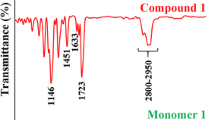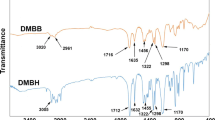Abstract
In this work, a new dimethacrylate monomer named α,α′-Bis(4-(2′-hydroxy- 3′methacryloyloxy-propoxy)-3,5-dimethylphenyl)-1,4-diisopropyl-benzene (α,α′-BHMPDDB) was synthesized to replace 2,2-bis[4-(2′-hydroxy-3′-methacryloyloxy-propoxy)-phenyl]propane (Bis-GMA) as one component of dental composite materials. The structures of α,α′-BHMPDDB and its intermediate product α,α′-Bis(4-oxiranylmethoxy-3,5-dimethylphenyl)-1,4-diisopropylbenzene (α,α′-BODDB) were confirmed by FT-IR, 1H-NMR, and elemental analysis. α,α′-BHMPDDB was mixed with TEGDMA to form a new dental resin, and double bond conversion, polymerization shrinkage, contact angle, water sorption and solubility, flexural strength and modulus before and after water immersion of this new dental resin were studied. Compared with the commonly used Bis-GMA/TEGDMA dental resin, α,α′-BHMPDDB/TEGDMA had higher double bond conversion (60.5 ± 0.3 %), lower polymerization shrinkage (5.6 %), and comparable flexural strength before water immersion (94.1 ± 3.9 MPa), which made α,α′-BHMPDDB/TEGDMA having potential to replace Bis-GMA/TEGDMA as matrix phase of dental composites materials. However, α,α′-BHMPDDB/TEGDMA also had drawbacks, such as higher water sorption (5.06 ± 0.17 %), water solubility (2.37 ± 0.1 %), and lower flexural strength after water immersion (71.4 ± 14.6 MPa).








Similar content being viewed by others
References
Nie J, Shi SQ (2008) Dimethacrylate based on cycloaliphatic epoxide for dental composite. Dent Mater 24:530–535
Güngör A, Apohan NK, Mert A, Kahraman MV (2008) Preparation and characterization of light curable hybrid coating: its potential application for dental restorative material. J Polym Res 15:389–395
Moszner N, Salz U (2001) New developments of polymeric dental composites. Prog Polym Sci 26:535–576
Asmussen E, Peutzfeldt A (1998) Influence of UEDMA, Bis-GMA and TEGDMA on selected methcanical properties of experimental resin composites. Dent Mater 14:51–56
Chung CM, Kim MS, Kim JG, Jang DO (2002) Synthesis and photopolymerization of trifunctional methacrylates and their application as dental monomers. J Biomed Mater Res 62:622–627
Tobolsky AV, Leonard F, Roeser GP (1948) Use of polymerizable ring compounds in constant volume polymerizations. J Polym Sci 3:604–606
Ge J, Trujillo M, Stansbury J (2005) Synthesis and photopolymerization of low shrinkage methacrylate monomers containing bulky substituent groups. Dent Mater 21:1163–1169
Satsangi N, Rawls HR, Norling BK (2004) Synthesis of low-shrinkage polymerizable liquid-crystal monomers. J Biomed Mater Res Part B: Appl Biomater 71B:153–158
Atai M, Ahmadi M, Babanzadeh S, Watts DC (2007) Synthesis, characterization, shrinkage and curing kinetics of a new low-shrinkage urethane dimethacrylate monomer for dental applications. Dent Mater 23:1030–1041
He JW, Luo YF, Liu F, Jia DM (2010) Synthesis, characterization and photopolymerization of a new dimethacrylate monomer based on (α-methyl-benzylidene) biphenol used as root canal sealer. J Biomat Sci-Polym E 21:1191–1205
He JW, Luo YF, Liu F, Jia DM (2010) Synthesis and characterization of a new trimethacrylate monomer with low polymerization shrinkage and its application in dental restoration materials. J Biomater Appl 25:235–249
He JW, Liao LL, Liu F, Luo YF, Jia DM (2010) Synthesis and characterization of a new dimethacrylate monomer based on 5,5′-bis(4-hydroxylphenyl)-hexahydro-4,7-methanoindan for root canal sealer application. J Mater Sci: Mater Med 21:1135–1142
Kim JG, Chung CM (2003) Trifunctional methacrylate monomers and their photocured composites with reduced curing shrinkage, water sorption, and water solubility. Biomaterials 24:3845–3851
Podgórski M (2011) Synthesis and characterization of acetyloxypropylene dimethacrylate as new dental monomer. Dent Mater 27:748–754
Huang YJ, Chen LD (1998) Effects of chemical composition and structure of unsaturated polyester resins on the miscibility cured sample morphology and mechanical properties of styrene/unsaturated polyester/low-profile additive ternary systems: 2. Mechanical properties. Polymer 39:7049–7059
Dong JP, Chiu SG, Hsu MW, Huang YJ (2006) Effects of reactive low-profile additives on the volume shrinkage and internal pigmentability for low-temperature cure of unsaturated polyester. J Appl Polym Sci 100:967–979
Venhoven BAM, de Gee AJ, Davidson CL (1993) Polymerization contraction and conversion of light-curing BisGMA-based methacrylate resins. Biomaterials 14:871–875
Patel MP, Braden M, Davy KWM (1987) Polymerization shrinkage of methacrylate esters. Biomaterials 8:53–56
Magali D, Delphine TB, Jacques D, Gäetane L (2006) Volume contraction in photocured dental resins: the shrinkage-conversion relationship revisited. Dent Mater 22:359–365
Sideridou I, Tserki V, Papanastasiou G (2003) Study of water sorption, solubility and modulus of elasticity of light-cured dimethacrylate-based dental resins. Biomaterials 24:655–665
Ronald EK, Lisa AK, Benjamin G (2009) Synthesis and evaluation of modified urethane dimethacrylate resins with reduced water sorption and solubility. Dent Mater 25:302–313
Stansbury JW, Antonucci JM (1999) Dimethacrylate monomers with varied fluorine contents and distributions. Dent Mater 15:166–173
Wang G, Culberton BM, Xie D, Seghi RR (1999) Effect of fluorinate trethylene glycol dimethacrylat on the properties of unfilled, light cured dental resins. J Macromol Sci Pure Appl Chem 36:237–252
Sideridou ID, Karabela MM, Vouvoudi EC (2008) Dynamic thermomechanical properties and sorption characteristics of two commercial light cured dental resin composites. Dent Mater 24:737–743
Söderholm KJ, Zigan M, Ragan M, Fishlshweiger W, Berman MJ (1984) Hydrolytic degradation of dental composites. J Dent Res 63:1248–1254
Costella AM, Trochmann JL, Oliveira WS (2010) Water sorption and diffusion coefficient through an experimental dental resin. J Mater Sci Mater Med 21:67–72
Hansel C, Leyhausen G, Mai UEH, Geurtsen W (1998) Effects of various resin composite (co)monomers and extracts on two caries associated micro-organisms in vitro. Dent Mater 77:60–67
Spahl W, Budzikiewicz H, Geursten W (1994) Extactable residual monomers from various resin materials-a qualitative study. J Dent Res 73:295
Acknowledgement
We would like to greatly thank technical assistant Vigren Minttu for her help in volumetric polymerization shrinkage testing. The study was funded by Natural Science Foundation of Guangdong Province, China; contract grant numbers:815106401000048, S2011020001452.
Author information
Authors and Affiliations
Corresponding author
Rights and permissions
About this article
Cite this article
He, J., Liu, F., Vallittu, P.K. et al. Synthesis of dimethacrylates monomers with low polymerization shrinkage and its application in dental composites materials. J Polym Res 19, 9932 (2012). https://doi.org/10.1007/s10965-012-9932-3
Received:
Accepted:
Published:
DOI: https://doi.org/10.1007/s10965-012-9932-3




